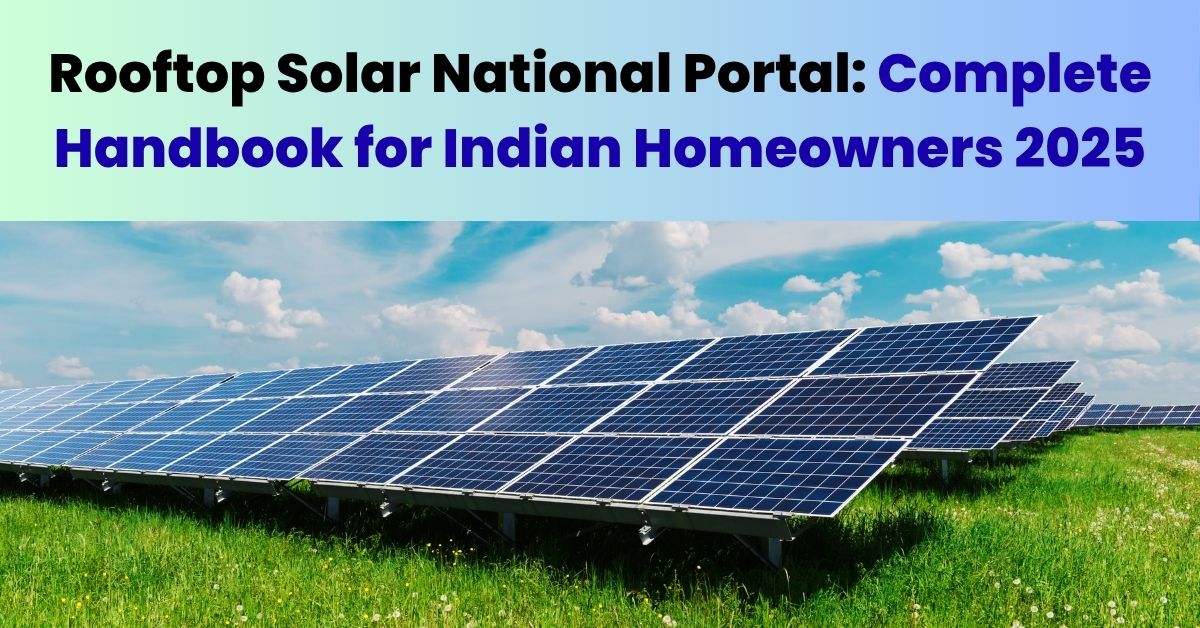In India, the demand for reliable, inexpensive, and clean energy has never been greater. Millions of homeowners are looking for better alternatives to traditional power as environmental concerns grow and electricity prices rise. The most promising option is solar energy, particularly when installed on rooftops. However, how can you begin your solar journey in a way that is safe, economical, and seamless? Your solution is the National Portal for Rooftop Solar.
The Ministry of New and Renewable Energy (MNRE) launched the National Portal For Rooftop Solar, a one-stop online resource that helps you find reliable solar suppliers, apply for generous government subsidies, and monitor your solar project from beginning to end. Everything you need to know is covered in this guide, allowing you to switch to solar energy with confidence and take advantage of cleaner energy, cheaper bills, and a more sustainable home.
Comprehending the Rooftop Solar National Portal
Let’s start with the fundamentals: Why was the National Portal For Rooftop Solar established, and what is it all about?
The National Portal: What is it?
National Portal for Rooftop Solar: PM Surya Ghar
An official government website called the National Portal For Rooftop Solar (pmsuryaghar.gov.in) was created to streamline and centralize every facet of residential solar rooftop adoption in India. The portal serves as your online gateway to:
• Submit an application for a rooftop solar system.
• Verify your eligibility for solar subsidies.
• Choose authorized, government-approved suppliers.
• Obtain comprehensive, detailed instructions for the installation procedure.
• Track the status of your application and subsidy in real time.
• Utilize the integrated tools to determine the system size and possible savings.
Why Was the National Rooftop Solar Portal Developed?
In the past, homeowners frequently had to deal with issues like opaque pricing, unclear documentation, a lack of confidence in vendors, and delays in receiving subsidies. By uniting all parties involved—homeowners, suppliers, power distribution companies (DISCOMs), and the government—onto a single, reliable platform, the National Portal For Rooftop Solar addresses these problems.
Who Is Able to Use the Portal?
• Any Indian citizen who rents or owns a home with a working electrical connection
• Tenants with the written consent of the owner (NOC); • Housing societies and resident welfare associations (for common area solar)
Every Indian home can now access solar energy in an efficient, reliable, and profitable manner thanks to the National Portal For Rooftop Solar.
The Significance of Rooftop Solar

Using rooftop solar through the National Portal For Rooftop Solar is a contemporary necessity rather than merely a fad. Millions are switching for the following reasons:
1. Significant Electricity Bill Savings – Consider reducing your monthly expenses by 70–90%. You are not required to purchase electricity from the grid for each unit of solar energy produced by your panels. Even though grid prices continue to rise, that is a savings of lakhs of rupees over more than 25 years.
2. Government Incentives and Subsidies – After installation and approval, the National Portal for Rooftop Solar guarantees that you receive the maximum subsidy, which is credited directly to your bank. This significantly lowers your initial investment.
3. Guard Your House Against Power Outages – By ensuring that your house is powered when the grid isn’t, solar with net metering (and optionally with batteries) reduces your concerns about blackouts and power outages.
4. Increase the Value of Your Property- Rooftop solar-equipped homes typically sell for more money and attract environmentally conscious purchasers. Solar is an investment as well as a utility.
5. Encourage environmental protection- Your carbon footprint decreases with each kilowatt you produce. Up to 3.5 tons of CO2 emissions can be offset annually by a typical 3kW rooftop solar system, which is the same as planting more than 100 trees.
6. Independence in Energy- You take charge of your energy future. You can stop worrying about unstable grid supply and government tariffs.
7. Extended Lifespan and Low Maintenance- Low maintenance is necessary for high-quality rooftop solar installations, which are managed by government-approved vendors on the National Portal For Rooftop Solar. Panels endure for more than 25 years. Batteries and inverters usually have warranties of five to ten years.
8. Support for National Objectives- By using solar, you’re combating climate change on a personal level and assisting India in meeting ambitious renewable energy targets.
To put it briefly, rooftop solar benefits the grid, the environment, your home, and your pocketbook.
Why are new adopters so fond of the National Portal for Rooftop Solar? The most important characteristics that set this portal apart for rooftop solar applications in India are as follows:
A. One-Stop Digital App – No more office visits, complicated procedures, or paperwork. Online registration, application, document uploading, application status tracking, and grievance support are all available.
B. Security and Transparency of Vendors – The list only includes government-approved solar installers and vendors who have been empanelled. This guarantees you warranty protection, appropriate after-sales support, and safe, high-quality installations.
C. Tracking Applications in Real Time – The portal dashboard allows you to track each step, including the submission of applications, DISCOM approvals, vendor installation, inspections, and subsidy credit.
D. Integrated Solar Calculators – Calculate the required rooftop area, the best capacity (in kW), the anticipated capital expenses, and your estimated subsidy. Find out how much you could save each year.
E. Integrated Subsidy Management: The portal handles all subsidy processing; there are no middlemen or manual chasing involved. The government immediately credits the subsidy to the bank account you provided after all approvals and inspections are finished.
F. Extensive Support and Resources: Throughout your rooftop solar adoption journey, you can access policy documents, user manuals, FAQs, and even a grievance redressal section if you have questions or need clarifications.
G. Safe and User-Friendly Design: Designed with data security and user-friendliness in mind, the National Portal For Rooftop Solar is accessible to everyone, regardless of technological proficiency.
The portal’s overall design prioritizes openness, confidence, and complete convenience, making sure that everyone’s journey toward rooftop solar is safe and easy.
How to Apply (Step-by-Step) for a Rooftop Solar System

It has never been easier to get started with the National Portal For Rooftop Solar. Here is a thorough tutorial so you can apply with assurance:
First Step:
• Sign up on the Rooftop Solar National Portal.
• Go to pmsuryaghar.gov.in.
• Select “Apply for Rooftop Solar.”
• Enter your consumer number (as shown on your electricity bill), state, and electricity DISCOM name.
• Enter your email address and mobile number. An OTP will be sent to you for validation.
• Finish the registration procedure.
Step 2:
• Complete the Online Application.
• Enter your registered information to log in.
• Enter the necessary personal information, such as name, address, phone number, and power connection information.
• Indicate the required system size (kW); if in doubt, use the calculator on the portal.
• Decide if your system will use batteries for storage or be grid-connected, which is the most popular option.
•All necessary documents (listed below) should be uploaded in soft copy.
Step 3:
Approval of DISCOM Technical Feasibility
• Following the submission of your application, the technical viability is assessed by your local power distribution company (DISCOM), which looks at grid readiness, available space, and roof strength.
• The portal provides real-time process tracking.
Step 4:
Select an Approved Vendor The portal shows the local empanelled vendors following DISCOM approval.
• Evaluate options according to warranty offers, years of experience, reviews, and price.
• Choose a vendor; the portal assists in starting the work order process with them.
Step 5:
System Installation: The vendor sets up a joint site survey, which may be conducted in person or virtually if necessary.
• The MNRE and BIS (Bureau of Indian Standards) safety regulations were followed when installing your rooftop solar system.
• After approval, the majority of systems (1–10kW) are finished in 7–15 working days.
Step 6:
Installing Net Meters After installation, apply for “net metering” (still through the portal) so that you can export excess power that is generated back to the grid.
• The net meter installation is scheduled by your DISCOM.
Step 7:
Last-Minute Exam and Commissioning
• A DISCOM or electrical inspector confirms that the system is installed correctly, is safe, and is operating as intended.
• On passing inspection, the net-metered system is officially commissioned.
Step 8:
Subsidy Disbursal
• Post commissioning, you upload the “Work Completion Report” and system generation/commissioning certificate.
• The National Portal For Rooftop Solar releases the eligible subsidy straight to your linked bank account within 15–30 days (may vary by location).
Tip: The portal keeps you updated at every step via SMS/email alerts and lets you raise support tickets or grievances if any step is delayed.
Details of Eligibility and the Subsidy
You must be aware of the fine print regarding who is eligible to apply and the amount of the subsidy in order to get the most out of the National Portal for Rooftop Solar.
Who Can Apply for Rooftop Solar Through the National Portal?
• Only residential consumers, which includes single-family homes, apartments, villas, and registered housing societies, are eligible for subsidies.
• If the applicant has documented authority, their name should appear on the electricity bill.
• For renters, the property owner must provide a NOC (No Objection Certificate) attesting to the tenant’s authorization to install rooftop solar.
• Each distinct electrical connection and property may only claim one rooftop solar subsidy claim.
Who Is Not Qualified?
• Businesses, stores, factories, and other commercial or industrial users need to get in touch with their state solar agency or local DISCOM directly.
• Properties with unlawful connections or unpaid electricity bills.
• Applicants who have previously received rooftop solar subsidies for the same property under another program.
Structure of Federal and State Subsidies

Central Subsidy (per PM Surya Ghar: Muft Bijli Yojana, starting in 2024):
• Maximum subsidy of 3kW (totaling ₹78,000 for a 3kW system); 40% subsidy for 2–3kW capacity; 60% subsidy for the first 2kW capacity; and no additional central subsidy for systems over 3kW.
• ₹18,000 per kW up to 500kW (at most 10kW per flat) for large apartment societies (RWAs).
State Subsidy:
A few states, like Gujarat and Madhya Pradesh, also provide additional incentives to encourage residential rooftop solar. Visit the energy/existing solar portal for your state to view the most recent policy updates. If both are applicable, the state subsidy is usually subtracted first, followed by the central subsidy.
Note: The rules governing subsidies may change. Always verify current numbers at the National Portal For Rooftop Solar.
Subsidy Disbursal
The entire subsidy is directly transferred to your bank account, ensuring zero leakage, no third-party interference, and no need to negotiate with vendors for subsidy receipts.
Documents Needed
The following should be prepared in easily readable formats to guarantee a seamless application process on the National Portal for Rooftop Solar:
1. A copy of the most recent electricity bill, with the name and address matching the application.
2. Identity Proof: Passport, PAN card, or preferred Aadhaar card.
3. Proof of Address: This can be a driver’s license, voter ID, ration card, or Aadhaar (if it matches the application address).
4. Proof of Property Ownership: A mutation certificate, a registered sale deed, or a property tax receipt. a current lease or rent agreement for renters.
5. Owner’s Permission (if a tenant): A NOC attesting to the property owner’s approval of rooftop solar installation, signed and stamped.
6. Bank Passbook/Statement or Cancelled Check: To directly credit your subsidy.
Success Tips:
• Make sure documents are readable by scanning them in color.
Verify for spelling and address errors.
• To prevent data leaks, only upload documents to the National Portal for Rooftop Solar’s secure document section.
The Principal Advantages of Solar Power on Rooftops
Let’s examine the strong arguments for using the National Portal For Rooftop Solar to meet your household’s energy requirements.
1. Decades of Dependable, Reasonably Priced Power
Solar panels have a 25–30 year lifespan. With little upkeep and no fuel expenses, your system saves you money year after year after it is installed.
2. Easy, Secure Installation
You can guarantee adherence to national safety regulations, certified equipment, and warranties by selecting vendors through the National Portal For Rooftop Solar.
3. Increased Return on Investment
In India, the majority of users recoup their initial investment in 4–6 years, after which energy is practically free for the system’s remaining years.
4. Encourage Environmental Goodwill
Your household can become a climate hero in your community by using clean solar power to offset tons of CO₂ and lessen your reliance on fossil fuels.
5. Tax and Statutory Benefits
Solar-equipped homes may be eligible for reduced property taxes or expedited building permits in certain states.
6. Defense Against Price Increases
By producing your own energy, you can lock in your cost. For decades, your panels will supply free electricity, even if grid rates increase.
7. Increased Value at Sale or Rental
Homes that are eco-friendly are valued higher. Given the potential savings, many buyers in major cities today favor homes with solar panels.
8. Simplicity of Growth
Begin with a modest 1–3kW system. To handle heavier loads, gradually add more panels as your budget permits.
9. Resolving Grievances Directly
To ensure government-monitored support, submit tickets via the National Portal For Rooftop Solar for any issue, including billing, installation delays, or net meters.
You can’t get such guaranteed savings, safety, and social value from any other energy investment!
How to Determine Your Savings and Rebates
To assist you in making informed decisions, the National Portal For Rooftop Solar offers a useful, easy-to-use calculator. Before you apply, let’s examine how it operates and why you should use it.
A. Calculating System Size and Space As a general rule, 1kW requires 8–10 square meters (including shadows). A 2kW system can usually be installed on a terrace that is 20 square meters in size.
• You might be able to fit more power in the same space with higher efficiency panels.
B. Determining Your Upfront Cost: Type in the size of the system you want.
• The market rate is estimated by the calculator using vendor price ranges and governmental regulations.
C. Determining Subsidy: Eligibility for the subsidy is shown immediately.
• For instance, a 3kW system may be directly credited up to ₹78,000 under the central scheme following installation and DISCOM inspection.
D. Projecting Energy Generation and Bill Savings The tool calculates likely monthly savings based on your electricity tariff and estimates your annual generation (a 3kW system in North India typically generates about 4,500–5,000 units/year).
E. Economic Returns The calculator displays the anticipated payback period, which is typically four to six years. Your energy is then free for the duration of the panel’s life.
F. Environmental Impact: Take note of the decline in CO2 emissions per year.
Determine ecological benefits, such as “equivalent trees planted.”
The Calculator: Why Use It?
It guarantees that you choose the best system and budget for your house, set realistic expectations, and avoid over- or under-investing.
Frequently Asked Questions (FAQs)
Q1: Can renters use the National Portal for Rooftop Solar to apply for rooftop solar?
Tenants who have a signed NOC (No Objection Certificate) from the property owner and an electricity bill in their name are eligible to apply for a rooftop solar installation through the National Portal For Rooftop Solar.
Q2: How long does it take to apply for and receive a rooftop solar subsidy through the National Portal?
The usual timeline is:
• Technical approval and registration: 1-2 weeks; vendor installation: 1-2 weeks after approval
• Subsidy credit: typically within 15–30 days following inspection; net metering and final service inspection: 1-2 weeks after installation
If all paperwork and the site are in order, the entire process should take one to two months.
Q3: Will my rooftop solar panel receive any maintenance or post-purchase assistance?
Indeed. According to MNRE regulations, government-approved suppliers on the National Portal for Rooftop Solar offer free operation and maintenance (O&M) for at least five years. Clean your panels once a month for optimal results, and look for any system alerts that the monitoring device has detected.
Q4: What are the advantages of using the National Portal for Rooftop Solar over contacting a private installer directly?
Quality control, vendor accountability, transparency, assured subsidy processing, and zero fraud risk. Under government supervision, every problem can be monitored and fixed.
Conclusion:
More than just a website, the National Portal For Rooftop Solar is at the center of India’s solar revolution, providing clean, reasonably priced energy to millions of families. This portal guarantees safe, regulated, and affordable access to the best rooftop solar solutions, regardless of whether you own or rent, live in an independent home, or live in an apartment.
You no longer have to deal with convoluted paperwork, bargain with unreliable sellers, or worry about losing out on government assistance. You can get all the information, resources, and official assistance you require from the National Portal for Rooftop Solar.
Solar power, which can be applied for through the National Portal For Rooftop Solar, is the best option if you want reduced energy costs, increased energy independence, a higher property value, and the satisfaction of contributing to the environment.
All set to go?
Get started on the path to a cleaner, brighter, and more independent future by visiting the official National Portal For Rooftop Solar, using the calculator to schedule your installation!
Distribute this guide to your loved ones. One roof at a time, let’s assist India in its solar energy transition!
Please bookmark our blog for more helpful energy-saving advice for Indian homes, share this article on the National Portal For Rooftop Solar on social media, and leave a comment below if you found it helpful!
This article was written purely for informational purposes; for updates and regulations specific to your area, always double-check the information with the official National Portal For Rooftop Solar.

